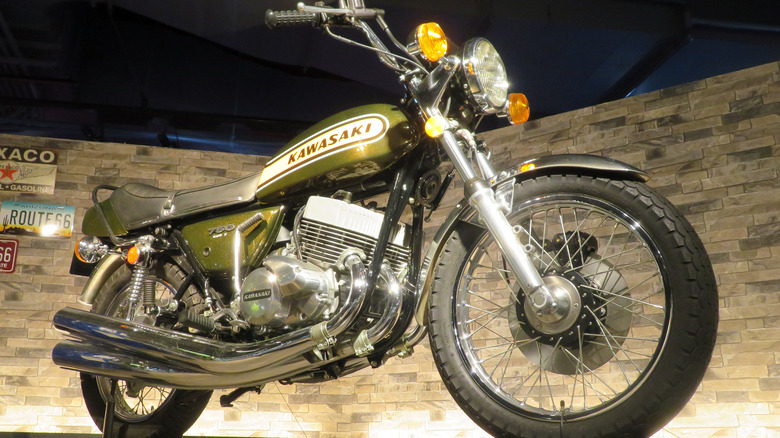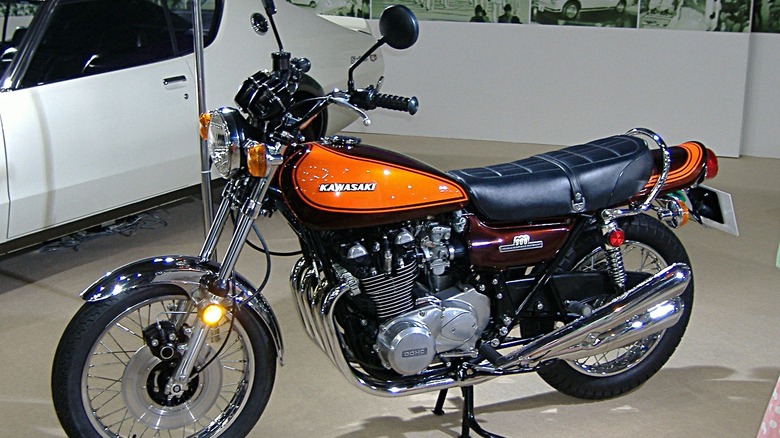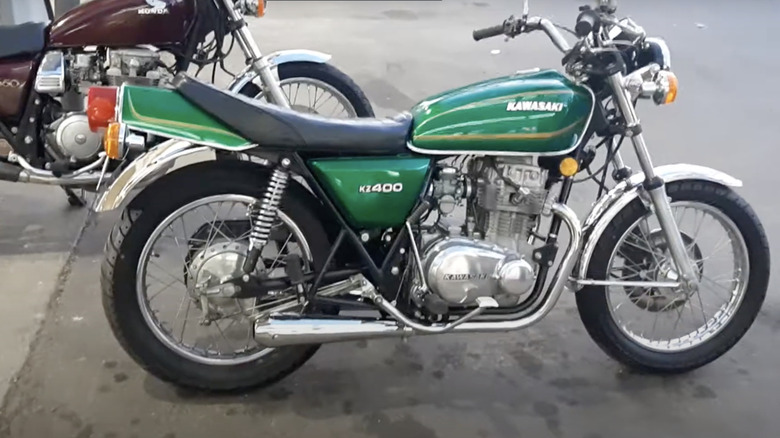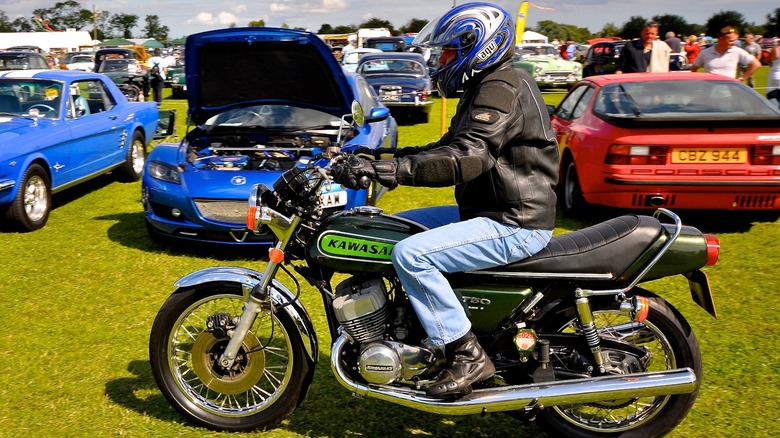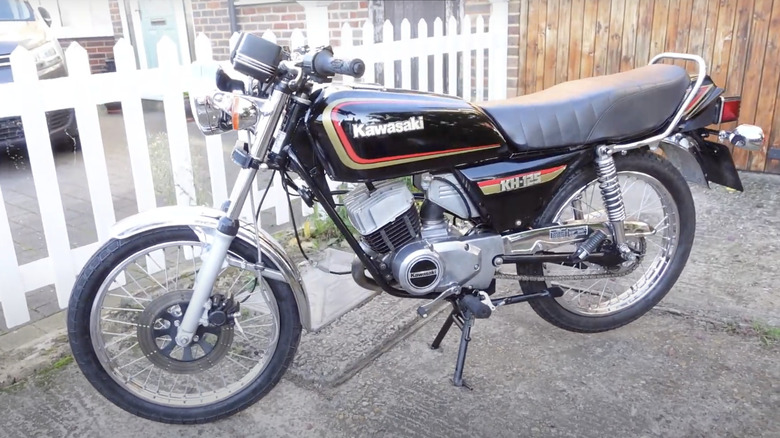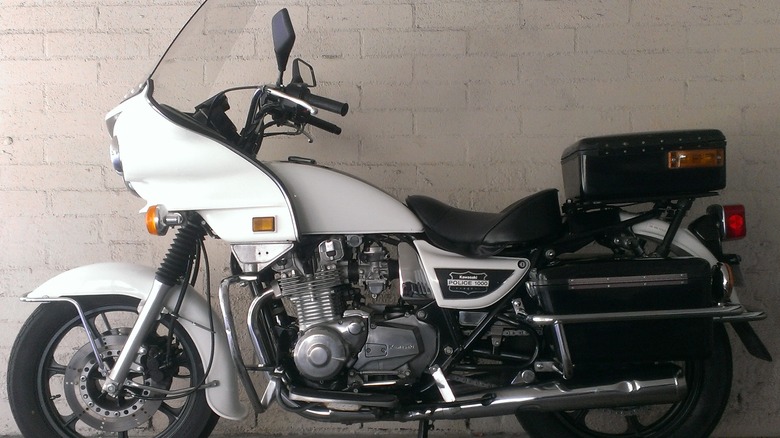5 Iconic Kawasaki Motorcycles From The 1970s
The 1970s were a high time for motorcycles, their fans, and manufacturers. The biker flick "Easy Rider" had been a sensation in 1969, and that same year Honda kick-started the superbike era with the releases of the CB750 and CR750.
Flocks of new motorcyclists were catching two-wheel fever, and Harley-Davidson built its first factory custom bike, the FX 1200 Super Glide, in 1971. Honda's fellow Japanese manufacturers weren't slacking either. Kawasaki's third-place spot on our ranking of the world's top motorcycle makers was based partially on its long-running Ninja series of superbikes, but the Ninja didn't make its debut until 1984. In the previous decade, Kawasaki contributed to the motorcycle craze with the five models below. They are among the company's best efforts and the era's most noteworthy, and some of them have become coveted collector's items a half-century later. One Kawasaki also landed a handful of starring roles on television and in movies, thanks largely to its popularity among police forces.
[Featured image by Tokumeigakarinoaoshima via Wikimedia Commons | Cropped and scaled | CC-BY SA 4.0]
The Z1 might be Kawasaki's most important model ever
When Honda released the CB750 in 1969, Kawasaki had its own 750 in the works. Wanting to clear the bar its competitor has just raised, Kawasaki's top brass authorized the development of a larger powerplant for its upcoming challenger to the CBR. Project "New York Steak" was born, so named because Yamaha president Yoji Hamawaki felt that was the best meal on American menus. Their efforts yielded a 903 cubic centimeter four-cylinder engine that made 82 horsepower and could get the Z1 past 130 miles per hour.
Kawasaki sent the Z1 to Daytona for testing in the spring of 1973, where it set a new land speed record and broke 50 others in three days of workouts. Bikers hopped on eagerly once it hit dealerships, taking 80,000 home in the first two years. At $1,895 (equal to about $13,500 today), they weren't cheap, and Hagerty currently values the debut 1973 model at between about $9,000 and $32,000 depending on condition.
[Featured image by Manju via Wikimedia Commons | Cropped and scaled | CC-BY SA 3.0]
The KZ400 bridged the gap between the Z1 and the Ninja
Kawasaki's engineers didn't spend all their late '60s and early '70s development time on the Z1, and customers of the brand also had some less powerful — but still impressive — Yamahas from which to choose. The KZ400's production run from 1974 to 1984 spanned the years between the Z1 and Ninja, although it was marketed as an efficient daily driver instead of a high-performance superbike. The KZ400 was powered by a 398 cubic centimeter two-cylinder engine that produced 35 horsepower at the crankshaft. It delivered over 50 miles per gallon of fuel efficiency, a major drawing card at the time of the KZ400's release in the summer of 1974.
That was just a few months after the OPEC oil embargo was lifted, and the average price of a gallon of gas jumped to 57 cents by 1975 (equal to about $3.45 today). The KZ400 had a chain-driven balancing unit in the crankcase that helped smooth out engine vibration, and at first it came with a pair of Keihin 36-millimeter carburetors. In 1977, those were swapped for 32-millimeter versions for fuel savings, and Kawasaki ran ads based on Volkswagen's famous "Think Small" Beetle campaign urging buyers to "Think Even Smaller" and buy a KZ400 instead.
The H2 Mach IV 750 was a wild beast
Kawasaki wasn't just urging buyers to "think even smaller" in the 1970s. Early in the decade, it produced the H2 Mach IV, a big, beefy bike with an engine to match. The H2 Mach IV was released in 1972 with a two-stroke 748 cubic centimeter three-cylinder engine that cranked out a healthy 74 horsepower and just over 57 foot-pounds of torque. It was a quirky bike, with neutral at the bottom of the shift lever instead of in the typical position between first and second. It earned the nickname "The WIdowmaker," and it beat the Z1 to market by a year and a half.
The H2 Mach IV was not a beginner's bike, with a dry weight of over 450 pounds, ample low-end grunt, and wonky handling. After that first year, the engine was detuned slightly to increase fuel mileage, and by 1974, power output was down to 71 horsepower. The H2 Mach IV stayed in production for one year after that, and Hagerty values a 1972 model at just under $17,000 in good condition. Kawasaki brought the H2 designation back for the supercharged Ninja H2 and racetrack-only H2R – a bike that has an astonishing top speed and acceleration.
[Featured image by Bridge Boy via Wikimedia Commons | Cropped and scaled | CC-BY 2.0]
The KH125 lasted well beyond the 1970s
Kawasaki's KH125 wasn't as exciting as the Z1 or dangerous as the H2 Mach IV, but this model endured for 20 years after its introduction in the late '70s. It delivered an impressive 65 miles per gallon thanks to the 123 cubic centimeter one-cylinder engine that delivered a modest 12 horsepower. That was plenty of juice for a bike that weighed just a touch over 200 pounds, though. The KH125 rode on 18-inch wheels with disc brakes in front and drums at the back, and power went to that back wheel via a five-speed transmission and chain drive.
The manageable weight and seat height of just under 31 inches made the KH125 a good choice for smaller riders, and the model developed a reputation for reliability during its two-decade run. Its quarter-mile time of about 19 seconds meant it wasn't going to wow spectators at the drag strip, but the KH125 served as a solid starter bike and commuting machine.
The KZ1000 succeeded the Z1
After its rivals responded to the Z1's release with superbikes of their own, Kawasaki went to work on a successor for its revolutionary beast. In 1976, the KZ1000 hit the road with a four-cylinder engine that displaced 1,015 cubic centimeters. The updated engine produced 83 horsepower and 58.6 pound-feet of torque, with both of those peaks arriving lower in the rev range than they did with the Z1's 903cc four.
Cycle World singled out the KZ1000 as the fastest production bike they'd ever tested, declaring that it "handles better, is quieter, and burns less fuel" than the Z1. The KZP police version was used by the California Highway Patrol and starred on "ChiPs" as the chosen ride of Jon Baker (Larry Wilcox), Frank Poncherello (Erik Estrada), and their fellow officers. Keanu Reeves drove a 1976 KZ1000 in the 1996 action film "Chain Reaction," and the KZ1000P appeared in 1991's "Terminator 2:Judgement Day."
[Featured image by Steve Glover via Wikimedia Commons | Cropped and scaled | CC-BY SA 2.0]
